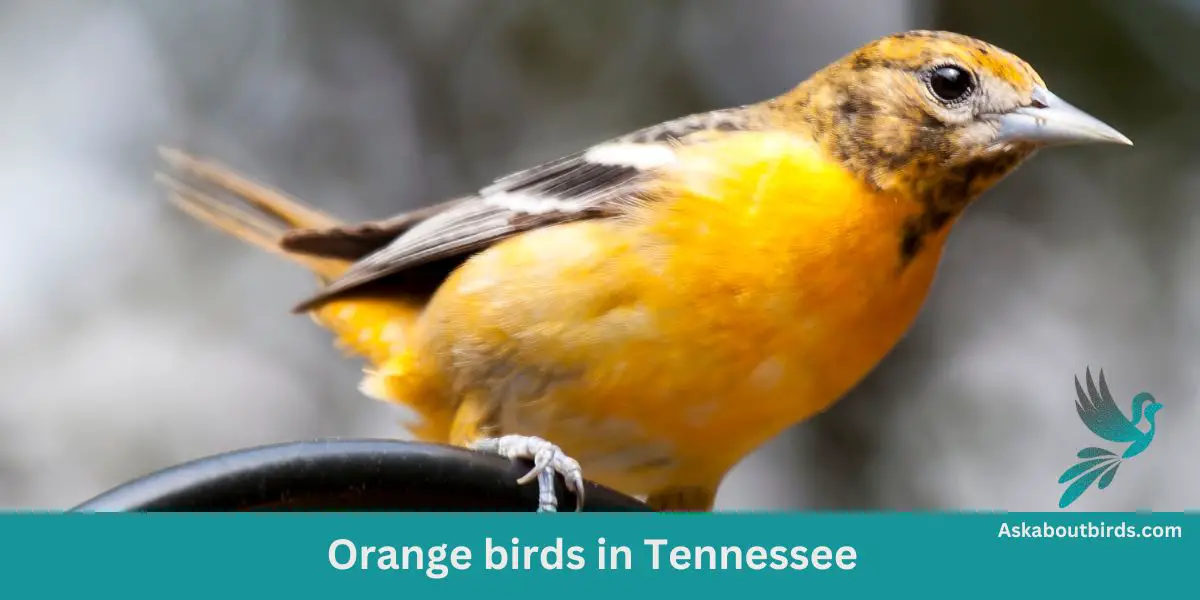From the tranquil woodlands to the bustling heart of Music City, Tennessee is not just a haven for music enthusiasts but also a paradise for birdwatchers. Discover the vibrant symphony of colors with our list of 9 captivating orange birds native to the Volunteer State.
Orange Birds Found In Tennessee
Tennessee’s unique geographical position, nestled between the Appalachian Mountains to the east and the Mississippi River to the west, creates a convergence of diverse habitats. This rich mosaic, ranging from highland forests to lowland wetlands, provides a haven for an extensive variety of bird species.
Baltimore Oriole


| Feature | Measurement |
|---|---|
| Scientific Name | Icterus galbula |
| Length | 6.7–8.7 in |
| Wingspan | 9.1–12.6 in |
| Weight | 22.3-42 g |
The Baltimore Oriole is a stunning bird, best known for its vibrant coloration and its rich, whistling song.
Appearance: The male Baltimore Oriole is notable for his bright orange and black plumage and black and white wing bars, a stark contrast to the more muted yellow-brown coloration of the female. Both sexes, however, have long pointed bills and white bars on their wings.
Diet: Baltimore Orioles have a diverse diet that includes insects, fruits, and nectar. Their preference for sweet juices and fruit pulp often brings them to backyard feeders offering oranges and jelly.
Reproduction: The female Baltimore Oriole is responsible for building the distinctive hanging nest, often woven together from fine materials like hair and grass. These nests are usually high in trees to avoid predators. The female lays 3-7 eggs, which are incubated for about two weeks.
Orchard Oriole
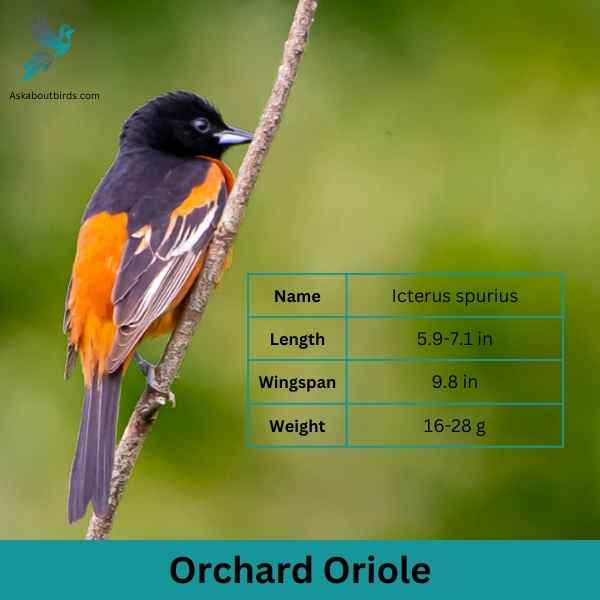
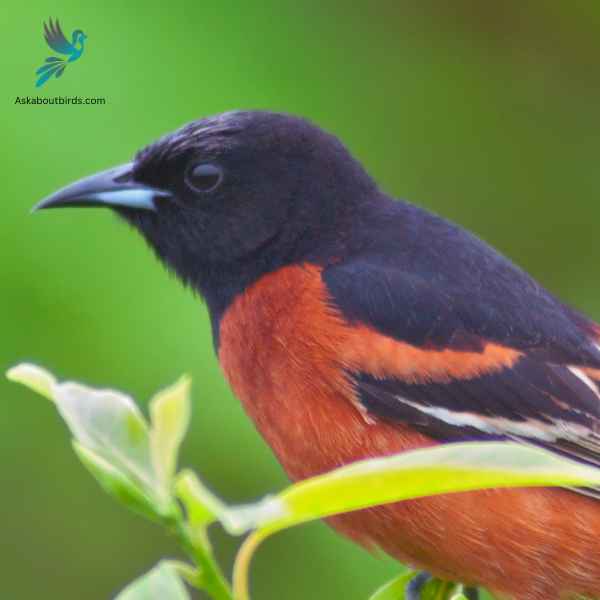
| Feature | Measurement |
|---|---|
| Scientific Name | Icterus spurius |
| Length | 5.9-7.1 in |
| Wingspan | 9.8 in |
| Weight | 16-28 g |
The Orchard Oriole is a small songbird noted for its distinctive coloration and melodic song.
Appearance: Male Orchard Orioles are a striking sight with their dark chestnut body and black head and black and white wings, while females and immature males are olive-green and feature a yellowish underpart. The species is often recognized by its slender body and pointed bill.
Diet: The diet of the Orchard Oriole consists primarily of insects, fruits, and nectar. They are adept at catching insects mid-air and are also known to sip nectar from flowers, aiding in pollination. When fruits are in season, they make up a substantial portion of the bird’s diet.
Reproduction: Orchard Orioles often nest in open woodlands and orchards, hence their name. The female is responsible for building the nest, typically choosing a location in a tree or shrub. The female lays a clutch of 4 to 6 eggs, which she incubates for about two weeks.
Red-breasted Nuthatch

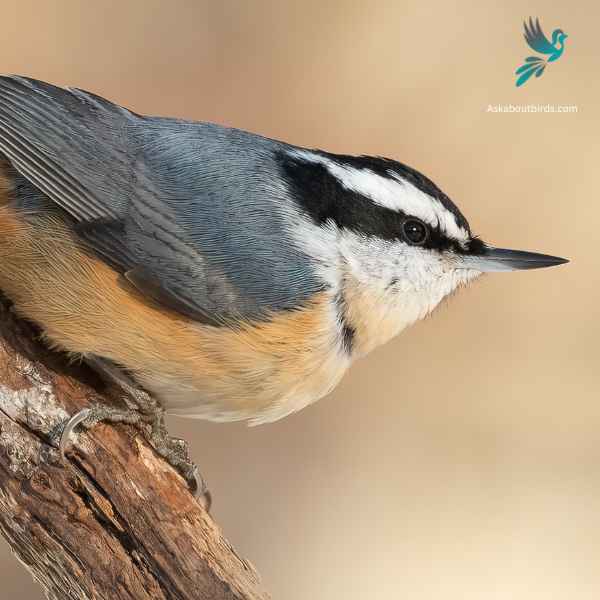
| Feature | Measurement |
|---|---|
| Scientific Name | Sitta canadensis |
| Length | 4.3–4.7 in |
| Wingspan | 8.3 in |
| Weight | 0.3–0.5 oz |
The Red-breasted Nuthatch is a small, agile songbird, known for its ability to move headfirst down tree trunks while searching for food.
Appearance: This bird boasts a slate-blue back and a pale rust-red underside. A prominent black stripe runs through the eye and is bordered above by a white eyebrow. Their sharp, pointed bill is characteristic of the species.
Diet: Red-breasted Nuthatches primarily feed on insects and seeds, especially those from coniferous trees. They have a fondness for large seeds, which they wedge into bark crevices to hack open with their bills.
Reproduction: These birds construct nests in natural tree cavities or abandoned woodpecker holes, often lining the entrance with resin. This is thought to deter predators or competitors from entering. The female typically lays a clutch of 5 to 6 eggs, and both parents partake in feeding the chicks once they hatch.
Barn Swallow

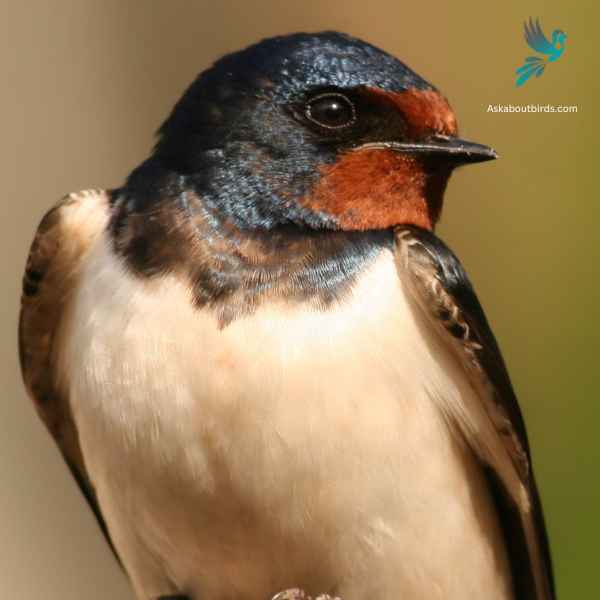
| Feature | Measurement |
|---|---|
| Scientific Name | Hirundo rustica |
| Length | 6.5–7.5 in |
| Wingspan | 12.5–13.5 in |
| Weight | 16–22 g |
The Barn Swallow is a sleek, agile bird renowned for its graceful flight patterns and iconic forked tail, often seen darting over fields and water bodies in search of flying insects.
Appearance: Barn Swallows have deep blue, almost iridescent, upperparts and a rufous to tawny underbelly. Their distinctively forked tail and long wings give them a streamlined look. Both males and females have a similar appearance, though males often exhibit slightly brighter colors and a deeper fork in the tail.
Diet: Barn Swallows feed primarily on flying insects, which they catch in mid-air during their agile and acrobatic flights. Their diet includes flies, beetles, moths, and other small flying insects.
Reproduction: Barn Swallows are known for building their mud nests on man-made structures, particularly barns, bridges, and eaves. The nest is cup-shaped and made from mud pellets, often lined with feathers. The female lays a clutch of 4 to 6 eggs.
American Robins


| Feature | Measurement |
|---|---|
| Scientific Name | Leptotila plumbeicep |
| Length | 10.6-11.8 in |
| Wingspan | — |
| Weight | 160-200 g |
The American Robin is a widely recognized bird species known for its melodious song and early bird tendencies.
Appearance: American Robins are medium-sized birds with a distinctive appearance. Both males and females sport a gray to brown back and a warm red to orange breast and belly and gray wings. They also have a characteristic white eye-ring and a black head, but males are usually darker than females.
Diet: American Robins have a diverse diet that changes depending on the season. In summer, they feed heavily on earthworms, beetles, and other invertebrates, which they catch on the ground. During winter, they mostly eat fruits and berries.
Reproduction: American Robins usually build their nests in trees or shrubs, but they are also known to nest on human-made structures. The female lays a clutch of about 3 to 5 eggs, which she incubates for about 12 to 14 days.
American Redstart


| Feature | Measurement |
|---|---|
| Scientific Name | Setophaga ruticilla |
| Length | 4.3 to 5.5 in |
| Wingspan | 6.3 to 9.1 in |
| Weight | 8.6 g |
The American Redstart is a lively warbler known for its vivid colors and active hunting style, often seen flitting about, fanning its tail to startle and catch insects.
Appearance: Adult male American Redstarts boast striking black plumage with bright orange patches on the sides, wings, and tail. Females and immature males have grayish-olive upperparts with yellow patches in the same areas where the males display orange.
Diet: American Redstarts are primarily insectivores. They actively forage for flying insects, as well as caterpillars and spiders, often using their colorful tails to startle prey and make them easier to catch.
Reproduction: The female American Redstart builds a cup-shaped nest in the fork of a tree branch. Typically, she lays a clutch of 3 to 5 eggs. The female takes on the primary responsibility of incubating the eggs, while both parents participate in feeding the fledglings after they hatch.
Blackburnian Warbler
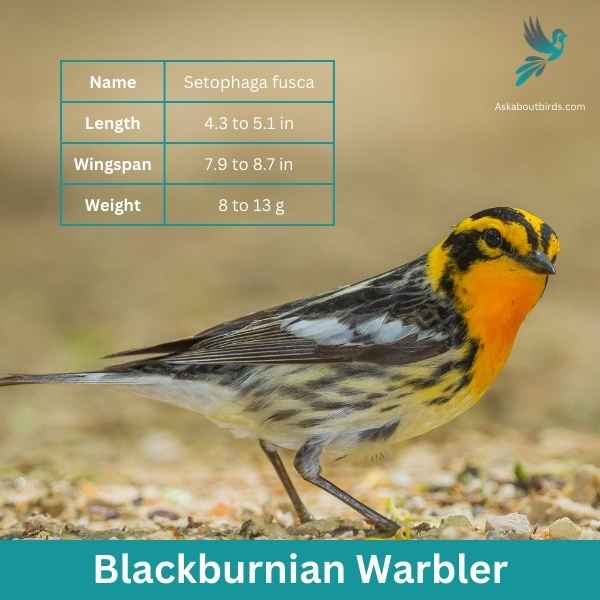

| Feature | Measurement |
|---|---|
| Scientific Name | Setophaga fusca |
| Length | 4.3 to 5.1 in |
| Wingspan | 7.9 to 8.7 in |
| Weight | 8 to 13 g |
The Blackburnian Warbler is a strikingly colored songbird that captivates observers with its vivid plumage, especially during the breeding season. Often found flitting high in the treetops of North American forests, its melodious song is as enchanting as its appearance.
Appearance: Male Blackburnian Warblers are distinguished by their fiery-orange throats, contrasting sharply with a black face, crown, and streaked back. They also have white underparts with black streaks on the sides. Females have a more muted coloration, with a yellowish or pale orange throat and less pronounced streaking.
Diet: Blackburnian Warblers primarily feed on insects and spiders. They are adept at foraging in the canopy, where they glean insects from the surface of leaves and branches or catch them mid-air in quick, agile flights.
Reproduction: Blackburnian Warblers build their nests high up in coniferous trees, often on horizontal branches. The nest is a neat cup made of twigs, grass, and moss, lined with softer materials like hair or feathers. The female lays a clutch of 4 to 5 eggs and takes the lead in incubation.
Red Crossbill

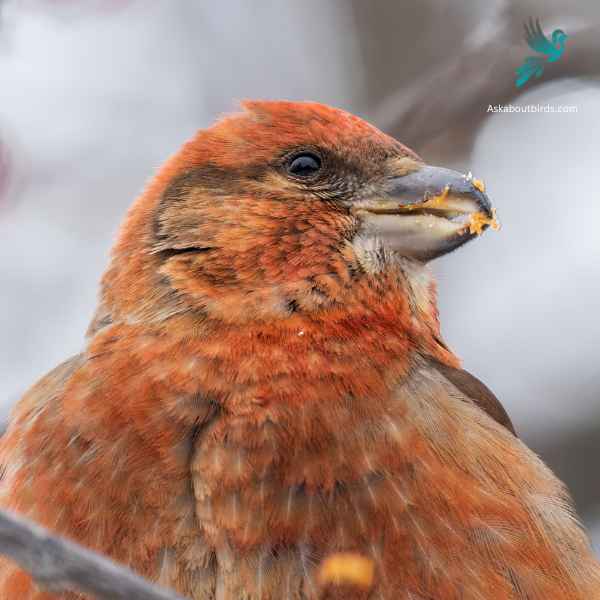
| Feature | Measurement |
|---|---|
| Scientific Name | Loxia curvirostra |
| Length | 5.5–7.5 in |
| Wingspan | 9.8–10.6 in |
| Weight | 0.9–1.4 oz |
The Red Crossbill is a distinctive finch known for its unusual bill, which has evolved to extract seeds from conifer cones.
Appearance: Males are typically bright red or orange, while females are greenish-yellow or olive. Both genders have the characteristic crossed bill, which they use to expertly extract seeds from tightly closed conifer cones.
Diet: Red Crossbills primarily feed on the seeds of coniferous trees, such as spruce, pine, and fir. Their specialized bills allow them to efficiently pry apart conifer cone scales to access the seeds.
Reproduction: Red Crossbills are somewhat nomadic and don’t adhere to a strict breeding schedule. Instead, they breed whenever and wherever food is abundant. Their nests are usually built on horizontal branches of conifer trees.
Eastern Towhee

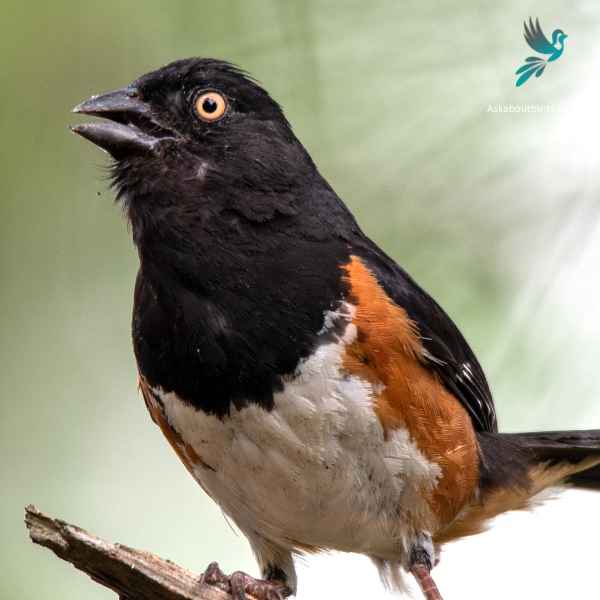
| Feature | Measurement |
|---|---|
| Scientific Name | Pipilo erythrophthalmus |
| Length | 6.8 to 9.1 in |
| Wingspan | 7.9–11.8 in |
| Weight | 32 to 53 g |
The Eastern Towhee is a distinctive songbird known for its unique calls and eye-catching coloration.
Appearance: Male Eastern Towhees are characterized by a striking combination of a black head, back and tail, contrasting with a white belly and rufous flanks. Females sport similar patterns but instead of black, they have a rich brown color. Both genders have red eyes, lending a special charm to their overall appearance.
Diet: Eastern Towhees primarily feed on a variety of insects, seeds, and berries. Their diet is quite diverse, taking advantage of seasonal offerings, which includes beetles, caterpillars, spiders, acorns, grass seeds, and various fruits and berries.
Reproduction: Eastern Towhees build their nests on or near the ground, often in a shrub or a small tree. The female lays around 3-5 eggs and takes the primary role in incubating them over about 12-13 days.
Where to Spot Tennessee’s Orange Birds
The verdant terrains of Tennessee are a tapestry of birdwatching havens. Here are the top spots where the state’s avian diversity, especially its brilliant orange birds, truly shines:
- Great Smoky Mountains National Park: Home to over 240 bird species, this iconic park offers high-elevation spruce-fir forests and lowland deciduous habitats. Here, the vibrant flame-colored warblers and orioles often steal the spotlight.
- Reelfoot Lake State Park: Formed by earthquakes in the early 19th century, this lake attracts an array of waterfowl and wading birds. Its cypress swamps are a great backdrop for spotting vibrant orange-colored birds among the green.
- Radnor Lake State Park: Located near Nashville, this park is a serene haven for birdwatchers. Its diverse habitats, from hardwood forests to lake shores, host a medley of songbirds, raptors, and waterfowl.
- Shelby Bottoms Greenway and Nature Park: This urban nature reserve in East Nashville boasts a variety of habitats including wetlands, fields, and forests. It’s a prime location to observe migratory birds, especially during spring and fall.
- Chickasaw National Wildlife Refuge: Resting along the Mississippi River, this refuge provides a crucial stopover for migratory birds. Its rich wetlands and hardwood forests are ideal for spotting everything from waterfowl to vibrant tanagers.
| State’s Orange Birds | Best Spots for Orange Birds |
|---|---|
| Kentucky’s Orange birds | 1. Mammoth Cave National Park 2. Daniel Boone National Forest 3. Lake Cumberland State Resort Park |
| Virginia’s Orange birds | 1. Shenandoah National Park 2. Great Dismal Swamp National Wildlife Refuge 3. Chincoteague National Wildlife Refuge |
| North Carolina’s Orange birds | 1. Pisgah National Forest 2. Cape Hatteras National Seashore 3. Alligator River National Wildlife Refuge |
| Georgia’s Orange birds | 1. Okefenokee Swamp Park 2. Chattahoochee National Forest 3. Cumberland Island National Seashore |
| Alabama’s Orange birds | 1. Wheeler National Wildlife Refuge 2. Bankhead National Forest 3. Dauphin Island |
| Mississippi’s Orange birds | 1. Noxubee National Wildlife Refuge 2. Gulf Islands National Seashore 3. De Soto National Forest |
| Arkansas’s Orange birds | 1. Hot Springs National Park 2. Ozark National Forest 3. Delta Rivers Nature Center |
| Missouri’s Orange birds | 1. Mark Twain National Forest 2. Mingo National Wildlife Refuge 3. Katy Trail State Park |
FAQs on Orange Bird Species Found in Tennessee
What kind of bird has an orange chest in Tennessee?
In Tennessee, the Baltimore Oriole is known for its vibrant orange chest. Male Baltimore Orioles are especially recognizable with their brilliant orange undersides contrasted by a black head, back, and wings.
What are the orange birds in Middle Tennessee?
In Middle Tennessee, apart from the Baltimore Oriole, another bird with orange coloration is the Orchard Oriole. While the males of this species have a deep russet-orange hue, they can still be recognized by their black head and upper parts.
What kind of bird has an orange beak in East Tennessee?
In East Tennessee, the American White Pelican stands out with its bright orange beak. Though these birds are more common in western states, they are known to migrate and can be spotted in parts of Tennessee during certain times of the year. Another bird, though less commonly spotted, with a vibrant orange bill is the Tundra Swan. This bird may pass through East Tennessee during migration.
Tennessee, with its rolling hills and lush forests, is a haven for a diverse range of wild birds. As the seasons shift, the landscape is often punctuated by the bright yellow of Yellow Warblers or the yellow throat of the Common Yellowthroat, especially along the forest edges. Meanwhile, the rusty orange breast of birds like the Eastern Towhee stands out, a vivid contrast to the green canopy.
The state also sees a plethora of orange and black birds, such as the Baltimore Oriole, which adds to the visual delight for bird enthusiasts. To lure these feathery visitors closer to their homes, many Tennesseans set up bird feeders. Stocked with black oil sunflower seeds, a favorite among many species, these feeders attract a myriad of birds, from those with black wings to the vibrant yellow birds.
Especially during winter, they visit bird feeders which vital sustenance sources for winter birds, ensuring they get the nourishment they need when food is scarce. Whether they eat seeds or hunt for insects, Tennessee’s avian inhabitants promise a mesmerizing experience for those keen on observing nature’s wonders.

